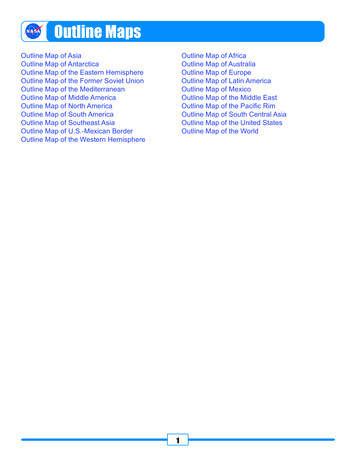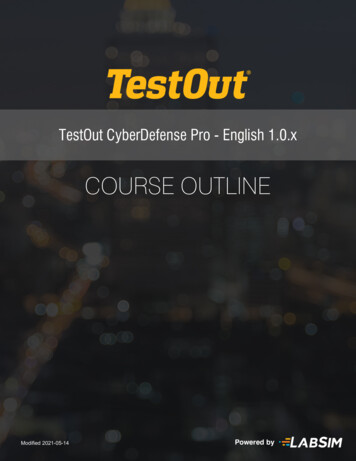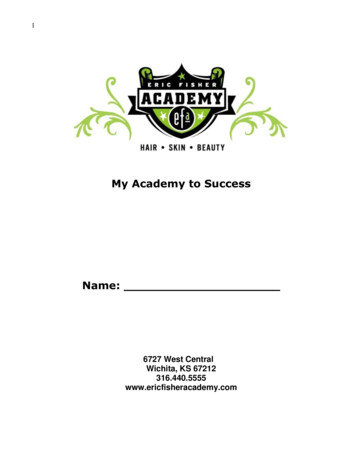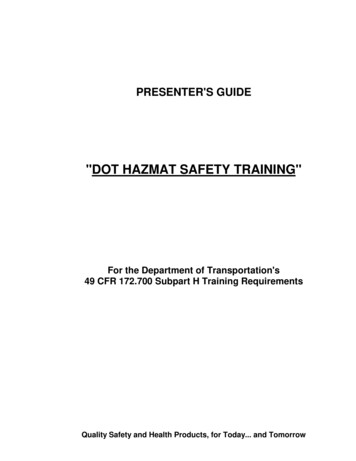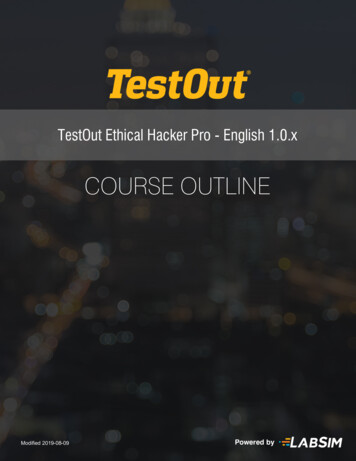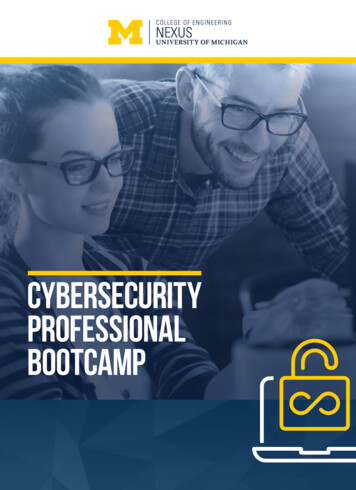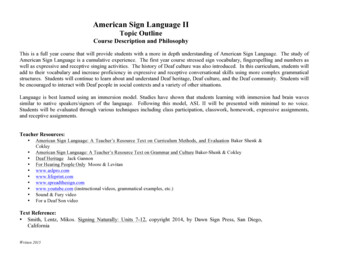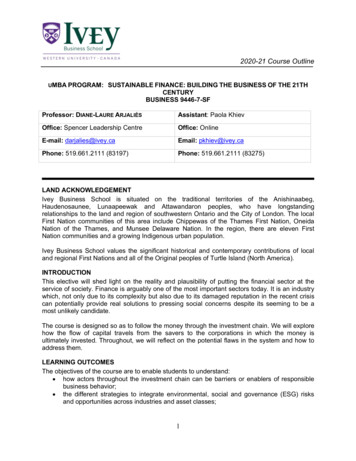
Transcription
2020-21 Course OutlineUMBA PROGRAM:SUSTAINABLE FINANCE: BUILDING THE BUSINESS OF THE 21THCENTURYBUSINESS 9446-7-SFProfessor: DIANE-LAURE ARJALIÈSAssistant: Paola KhievOffice: Spencer Leadership CentreOffice: OnlineE-mail: darjalies@ivey.caEmail: pkhiev@ivey.caPhone: 519.661.2111 (83197)Phone: 519.661.2111 (83275)LAND ACKNOWLEDGEMENTIvey Business School is situated on the traditional territories of the Anishinaabeg,Haudenosaunee, Lunaapeewak and Attawandaron peoples, who have longstandingrelationships to the land and region of southwestern Ontario and the City of London. The localFirst Nation communities of this area include Chippewas of the Thames First Nation, OneidaNation of the Thames, and Munsee Delaware Nation. In the region, there are eleven FirstNation communities and a growing Indigenous urban population.Ivey Business School values the significant historical and contemporary contributions of localand regional First Nations and all of the Original peoples of Turtle Island (North America).INTRODUCTIONThis elective will shed light on the reality and plausibility of putting the financial sector at theservice of society. Finance is arguably one of the most important sectors today. It is an industrywhich, not only due to its complexity but also due to its damaged reputation in the recent crisiscan potentially provide real solutions to pressing social concerns despite its seeming to be amost unlikely candidate.The course is designed so as to follow the money through the investment chain. We will explorehow the flow of capital travels from the savers to the corporations in which the money isultimately invested. Throughout, we will reflect on the potential flaws in the system and how toaddress them.LEARNING OUTCOMESThe objectives of the course are to enable students to understand: how actors throughout the investment chain can be barriers or enablers of responsiblebusiness behavior; the different strategies to integrate environmental, social and governance (ESG) risksand opportunities across industries and asset classes;1
2020-21 Course Outline what individuals (e.g. students, shareholders, citizens, managers and politicians),organizations and the society can do to reconnect finance to a sustainable realeconomy.GRADING COMPONENT SCHEMEWe strive to evaluate all available information in order to, at the end of the school year, arrive ata final grade that fairly reflects the student’s demonstrated capability in dealing with andunderstanding the course content. Evidence of this capability comes through classroomcontribution, examinations, reports and other vehicles that may be used throughout the course.The grade in this course is a composite of an individual project, group project and classroomcontribution. I will assign your grades for written and non-written work based on the following:Group Project50%Individual Project25%Classroom Contribution25%Total100%GROUP PROJECTOne of the goals of the MBA is to help you build a meaningful career and personal path. I alsohope that the MBA will give you the skills and courage to be a positive change maker in theworld. This group project will give you the opportunity to become this change agent.My goal with this assignment is threefold, to evaluate your ability to: 1) understand and applythe concepts we have learnt together through the class; 2) innovate and adapt to new contexts;3) work efficiently as a group. Each group should comprise six students.The world is at a tipping point where you can be the first generation to eradicate extremepoverty and transition from a fossil fuel economy into a world of renewable abundance. You canbe the generation that, through dignified work, economic opportunity and amplifying thestrengths of business, ends the need for war. The goal of this group research project is toempower you – MBA students – to evaluate and find financial innovations (e.g. products,operational designs, business models, multi stakeholder-initiatives, etc.) that can contribute totrigger business change towards sustainability. Innovations can include – but are not limited to –promoting finance as a force for:- Eradicating extreme poverty and hunger- Achieving universal primary education- Combatting HIV/AIDS, malaria and other diseases- Sustainable economies- Peace and security2
2020-21 Course Outline- Ensure environmental sustainability and generation- Global partnership for development- Human dignityThe focus is on integrating your learning about the relationship between finance andsustainability and applying this to evaluate what you judge to be a financial innovation that cantrigger change towards sustainability. You are welcome to suggest your own financialinnovations, provided they participate in making finance a positive catalyst to change behaviorand create a flourishing, sustainable planet.The presentation should include the following parts (not necessarily in this order):-An explanation of what the financial innovation consists of and why you chose it.-A discussion of the societal issue (in a broad sense of the term) addressed by thefinancial innovation and why it could contribute to both business and society.-Analysis of the interests that have a stake in the issue; the preferences of interestedstakeholders on the sustainability issue; their level of support or opposition for the firm’ssustainability challenge; their effectiveness in shaping the issue.-Discussion of plausible other options in addressing the societal/financial issue.Discussion of the various options’ expected (short- and long-term) implications for thestakeholders implied.-On the basis of your analysis, give a coherent, logical set of explanations why you thinkthis innovation is the best option to adopt to address the issue identified above both froma business and a societal perspective. Short- and long-term recommendations areadvised.-If you think that this innovation could be applied to other contexts or companies, suggestways to scaling up the financial innovation. If you think this innovation could not beapplied elsewhere, explain why.You can use companies’ sustainability reports, annual reports, media reports (e.g., New YorkTimes, Wall Street Journal, Business Week, Forbes, Fortune, and the Globe & Mail), analystreports, academic articles, and other reputable sources to conduct your analysis. Strongerreports might also include findings from short interviews with one or more managers, industry orother experts. Course concepts should be used in both the analysis and the recommendations.It is important that you i) reference all sources throughout the presentation, and ii) provide acomplete list of references. The presentation must be your own original work, written specificallyfor the course. Your report must not be a repetition of other course work. And, you may not useexisting published case study material or reports. For further details on referencing and3
2020-21 Course Outlineplagiarism, see the information and weblink provided in the following section “IV. OtherImportant Matters”.The presentation should last 20 minutes maximum. You should find that a presentation of thislength is very easy to assemble—your challenge is to convey an insightful presentation of thefinancial innovation you chose. For larger firms, focusing on a single line of business shouldhelp you to focus your presentation. Naturally, I expect to see sufficient depth to demonstrateyour understanding of key course concepts.This is a group assignment and every student is expected to contribute substantially to theteamwork. In order to mitigate any potential free-rider problem, peer evaluation could be takeninto account for grading. The assessment of the presentation will be made by your peers (25%)and myself (75%) based on the oral presentation and the annotated PowerPoint used forthe presentation accordingly:Evaluation Grid for the Group ProjectAssessed FeatureAn explanation of what the financial innovation consists of and why youchose it.A discussion of the issue addressed by the financial innovation and whyit could contribute to both business and society.Analysis of the interests that have a stake in the issue; the preferencesof interested stakeholders on the sustainability issue; their level ofsupport or opposition for the innovation; their effectiveness in shapingthe issue.Discussion of plausible other options in addressing this societal/financialissue.On the basis of your analysis, give a coherent, logical set of explanationswhy you think this innovation is the best option to adopt to address theissue identified above both from a financial and a societal perspective.Short- and long-term recommendations are advised.If you think that this innovation could be applied to other contexts orcompanies, suggest ways to scaling up the business innovation. If youthink this innovation could not be applied elsewhere, explain.Overall learning experience from the audience perspective.Overall quality of the presentation.“Ah ah” moment not included in the above list.Performance as a “group”.TOTAL4Number ofPoints551510151010101010100
2020-21 Course OutlineYou will need to provide the membership of your group on Learn before December 9th by 11pm, together with a one-page memo that describes your project. If you have not done it, I willrandomly assess students to group projects and pick up the topic.You will need to upload your video presentation on Learn before December 16th by 11 pm.Failures to do so will lead to a 10% decrease of your grade of the final presentation. Youwill no longer be able to upload your video presentation 24 hours after the deadline.You will need to assess your peer’s presentation on Learn before December 18th by 11pm. Failures to do so will lead to a 5% decrease of your individual contribution grade.INDIVIDUAL PROJECTMy goal in this individual project is to assess your analytical skills and ability to provide aconcise and insightful evaluation of a problem. Such abilities are essential to deliver a clearpoint, hence convincing your peers and hierarchy.For this individual project, I am asking you to write a note on the case titled “Oddo Securities –ESG Integration (HBS 9-111-085)” planned during Session 6, part B (asynchronously). Imaginethat you are writing an executive summary of the case that explains what is at stake and whatthe key takeaways are. Assume that you are working for an asset management companyoffering socially responsible investment funds.The note must not exceed 3 pages – 12 font – 1.5 interline.Below an evaluation grid your peers and myself will use to assess your note. Please bear inmind that you do not need to follow step by step this grid. I am welcoming any format, providedthe key messages are there. A case study analysis framework is available on Learn to help youwrite your note.You will have to upload your note on Learn before 11 pm on December 10th. In the unlikelycase you have not succeeded in writing this note, you will be given zero for this assignement.You will need to assess your peer’s individual project on Learn before December 18th by11 pm. Failures to do so will lead to a 5% decrease of your individual contribution grade.Evaluation Grid for the Individual ProjectAssessed FeatureDepth and conciseness of the noteAccuracy and overview of the diagnosed problemAdequate suggestion of key learningsAbility to understand the rationale used to make recommendations5Number ofPoints20202020
2020-21 Course OutlineAssessed FeatureNumber ofPoints20100Clear storylineTOTALCLASS CONTRIBUTIONYour participation in class will provide the basis for my judgment of your normal level ofday-to-day preparation. I expect you to be fully engaged in the entire learning process and youshould be prepared in each class to participate voluntarily and when called upon. This meansdevoting time and energy to preparation before class, including learning team meetings,listening to others during class discussions and engaging in class discussions. Collectivereasoning and discovery are critical to the successful application of the case method. Prior toany case discussion, engaging in discussions with (or examining notes from) others who mayhave already experienced a case is a clear violation of our norms.Your class contribution grade will be based on a daily assessment of your performance. Boththe quantity and quality of your class contribution will be assessed as indicated below. No creditwill be given for missed classes, although you might be asked to provide evidence of yourpreparation in writing.Asking questions can make high quality contributions to class when they advance generalunderstanding by stimulating an in-depth analysis or explanation of a point. Remember, themain objective of your contribution is not evaluation, but learning and helping your colleagues tolearn. The following list might be of some help.Outstanding Contribution (90-100%) Contributes at the highest levels throughout the class; Contributions indicate thorough preparation; Contributions reflect careful attention to the ongoing discussion; Contributions include strong follow-up comments and questions; Helps integrate operations concepts with other subjects; Frequently explains difficult points or concepts; Provides sustained strong support to enrich classroom learning; Builds and develops outstanding arguments for a position.Excellent Contribution (80-89%) Contributes frequently to discussions; Contributions indicate careful preparation; Contributions reflect attention to and consideration of the ongoing discussion; Explains difficult points and concepts; Helps guide class discussions; Regularly builds and develops strong arguments for a position.Good Contribution (70-79%)6
2020-21 Course Outline Contributes fairly regularly to discussions, but primarily in the beginning of the class;Contributions indicate consistent preparation;Contributions reflect thoughtful responses to the ongoing discussions;Raises questions that help focus on difficult points or concepts;Occasionally builds reasonable arguments for a position.Fair Contribution (60-69%) Contributes irregularly to class discussions; Gives occasional indication of preparation; Rarely builds on the ongoing discussion.Poor Contribution (50-59%) Contributes rarely to discussions; Gives little indication of preparation and thought; Does not aid in providing a positive atmosphere for meaningful discussion.Unsatisfactory Contribution (0-49%) Almost never contributes to discussions; Gives minimal indication of preparation or thought; Actively inhibits or impedes the course of class discussions; Misses a significant number of class sessions.Online participationIn keeping with Ivey best practice, part of your grade for classroom contribution will be based onevaluations by your classroom peers. I will select three students during each live session andask them to act as “co-producers”. One of them will track vocal contributions (name and quality)whereas the other two will track written contributions in the chat (name and quality). Quality isassessed based on a three-point scale: 1: provide a case fact; 2: effectively build on anotherstudent's comment; 3: breakthrough contribution. At the end of the day of the live session, each“co-producer” will send the peer-assessment to me (darjalies@ivey.ca) and Michelina Aguanno(maguanno.phd@ivey.ca), containing:- List of contributors and contribution quality (1-3 points).- A 500 words max. summary of the key discussion and learning points of the live zoomsession.Co-producers will be given a 3 in contribution score for the date. By the end of the course,manystudents would have acted as “co-producers” but unfortunately not all of the students canbecome co-producers due to the limited number of sessions. Selection is done randomly.Students attending the course virtually can contribute in two ways, weighted equally towardsyour final contribution score for the day: Vocal contribution. Please, raise your hand on zoom and/or respond when cold by theprofessor. Written contribution. Please send contributions through the private chat with the two chatco-producers.7
2020-21 Course OutlineHere below a short zoom discussion protocol to be followed during each live session: When you log into zoom, please mute yourself. I strongly suggest using headphones toavoid noise and facilitate learning. Under “participants” in the zoom window pop-up, you can raise your hand to askquestions. Only unmute yourself when you are called on. After you finish your comment,please mute yourself again. You can submit written comments using the online "chat" function on zoom. Please limityourself to at most *1* written comment. Zoom technology records your attendance automatically.DIVERSITYI welcome individuals of all ages, socio and economic backgrounds, beliefs, ethnicities,genders, gender identities, gender expressions, national origins, religious affiliations, politicalaffiliations, sexual orientations, ability, accents and other visible and nonvisible differences. Iconsider this classroom to be a place where you will be treated with respect. All members of thisclass are expected to contribute to a respectful, welcoming and inclusive environment for everyother member of the class. If it is appropriate to our learning and you feel comfortable doing so,I ask that you contribute comments and share your unique point of view as we explore thecourse content.IVEY EXPECTATIONSAt Ivey we are proud of the diversity in our students, faculty, staff, and alumni. You will workwith people who differ in their gender, race, religion, nationality, and sexual orientation. You willbenefit from these differences in the school in the form of higher diversity in thought. With thisbenefit comes the responsibility to value and respect each other despite and for theirdifferences. Any behaviour or language that is negative or harmful about someone’s gender,race, religion, nationality, and sexual orientation health is against Ivey’s values and will not betolerated.TEAM ASSIGNMENTSStudents completing team assignments will receive the same grade as their team members forthe same group report. Students are expected to contribute substantially to group work. Everystudent understands that all group members are equally responsible for the entire project unlessotherwise indicated by the professor. If an individual(s) has not contributed significantly to thegroup’s work, the individual in question may be severed from the group and receive a gradeindependent from the group. The faculty reserve the right to assign a failing grade to anyindividual who has not meaningfully contributed to the group. The faculty may request eachstudent to independently evaluate the contribution of other group members.ATTENDANCEAttendance at all sessions in this course are mandatory and it is your responsibility to advise meif you are unable to attend a class. Circumstances may arise which make it impossible for you toattend such as due to health-related reasons. If you are going to be absent, it is yourresponsibility to inform me prior to the start of the class. Students missing class, regardless of8
2020-21 Course Outlinethe reason, will not receive credit for class contribution, nor will class contribution grades be prorated to accommodate the number of missed classes.Any student who, in the opinion of the instructor, is absent too frequently from class orlaboratory periods in any course will be reported to the MBA Faculty Director (after due warninghas been given). Specifically, any student missing more than 25 percent of the classes will notbe permitted to receive credit for the course and will be debarred from taking the regularexamination in the course.See also Western’s Policy on Accommodation for Illness athttp://www.uwo.ca/univsec/pdf/academic policies/appeals/accommodation illness.pdfIn the event of an illness requiring medical documentation, please contact MBA ProgramServices for instructions.MATERIALSWe will utilize a variety of media and teaching methods, including cases, role-plays, videos,debates, guest speakers and simulation exercises.ACADEMIC OFFENSESScholastic offenses are taken seriously and students are expected to read the appropriatepolicies at: Scholastic Discipline for Graduate Students:http://www.uwo.ca/univsec/pdf/academic policies/appeals/scholastic discipline grad.pdfGraduate Student Academic Appeals:http://www.uwo.ca/univsec/pdf/academic policies/appeals/appealsgrad.pdfCODE OF CONDUCT POLICIES Western Code of Student Conduct: http://www.uwo.ca/univsec/pdf/board/code.pdf Ivey Student Code of Professional Conduct located in the Student Handbook. Western Non-Discrimination/Harassment p135.pdf The Code of Behavior for Use of Computer Resources and Corporate 13.pdfPLAGIARISMStudents must write their essays and assignments (at Ivey this includes case exams andreports) in their own words. Whenever students take an idea, or a passage from anotherauthor, they must acknowledge their debt both by using quotation marks where appropriate andby proper referencing such as footnotes or citations. Plagiarism is a major academic offence.All required papers (at Ivey this includes case exams and reports) may be subject to submissionfor textual similarity review to the commercial plagiarism detection software under license to theUniversity for the detection of plagiarism. All papers submitted will be included as sourcedocuments in the reference database for the purpose of detecting plagiarism of papers9
2020-21 Course Outlinesubsequently submitted to the system. Use of the service is subject to the licensing agreement,currently between Western University and Turnitin.com (www.turnitin.com).PROHIBITED INFORMATIONUnless explicit instructions are received from your instructor to the contrary, your preparationmust be limited to the information provided by your instructor(s), plus your own experience andthat of your class peers. Class contributions should be based exclusively on your preparationand discussions with members of your learning team or section classmates, and not augmentedwith information obtained anywhere else. Information related to cases that have been obtainedfrom sources other than your instructor in paper, electronic or verbal form is not permitted to beused for class contribution purposes. Such prohibited information includes, but is not limited to,the following: Hand-outs, including follow-on ("B") cases Exam or report feedback (related to a particular case) for other students or provided inother sections or years Notes, spreadsheets, etc. specific to cases (obtained before the case has been taught)prepared by students in other sections or years Company information that is not provided in the case (and that is not derived from yourown experience) Teaching notesIf it is determined that such prohibited information is used in class discussions, such an incidentwill be deemed to be a violation of Ivey's Student Code of Professional Conduct.HEALTH AND WELLNESS SERVICESAs part of a successful graduate student experience at Western, we encourage students tomake their health and wellness a priority. Western provides several on campus health-relatedservices to help you achieve optimum health and engage in healthy living while pursuing yourgraduate degree.Students seeking help regarding mental health concerns are advised to speak to someone theyfeel comfortable confiding in, such as a faculty member, the Faculty Program Director, or theMBA Program Services Director. Students who are in emotional and/or mental distress shouldalso refer to Mental Health@Western http://uwo.ca/health/mental wellbeing for a complete listof options about how to obtain help.OFFICE HOURS/APPOINTMENTSIf you wish to meet with me, please feel free to e-mail me after the end of the classes.DETAILED COURSE OUTLINE AND EXPECTED PREPARATION FOR EACH SESSIONPlease check Learn regularly for changes to the schedule and other course news.10
2020-21 Course OutlineDateThemeMondayDecember 7MorningSESSION 1 –“SUSTAINABLE”VS. “FINANCE”?Topic and Expected Preparation for Each SessionPART A: WHAT IS MONEY?Read: (In-person) Arjaliès, D-L. & Newton A. (2020), Background note:Functions of money and cryptocurrency, IveyPublishingVergne J-P., Lomazzo C., Hsieh Y. (2017), Bitcoincrash course. Crypto Capitalism ourseImpak coin, https://www.impak.eco/en/impak-coin/ skim the websiteIf the workings of blockchain of Bitcoin are not clear, pleasewatch:https://www.youtube.com/watch?v SSo EIwHSd4If the workings of the blockchain of impak Coin (i.e. Quorumby JP Morgan) are not clear, please watch:https://www.youtube.com/watch?v lwgOwEKW2z0Prepare: What are the differences and commonalitiesbetween the two cryptocurrencies?Why would a consumer “invest” in thosecryptocurrencies?Do you think they contribute to the building ofsustainable finance?PART B: FOLLOWING THE INVESTMENT CHAINRead:Arjaliès, D-L., Grant P., Hardie I., MacKenzie D. andSvetlova E., Introduction, Chains of Finance: HowInvestment Management is Shaped, Oxford UniversityPress, 2017.In class: Discussion of the actors on the investment chain11
2020-21 Course OutlineDateThemeTopic and Expected Preparation for Each Session MondayDecember 7AfternoonSESSION 2 –THE WORKINGSOF A FINANCIALMARKET(In-person)Identification of the flaws/transformative effectsPART A: THE MECHANISMS OF THE 2008 SUBPRIMEMORTGAGE CRISISIn-class:Discussion based on the movie the “Big Short” (McKay,2015)PART B: HAVE WE LEARNT OUR LESSONS?Prepare: TuesdayDecember 8Morning(Virtual)SESSION 3 –ON INCENTIVESDisrupting Wall Street: High Frequency Trading (IVEY9B14E021)1. What is the value creation process of HFT?2. What are the pros and cons of HFT?PART A: PROXY VOTINGGuest speaker:Aaron Bennett, Director & Senior Research AnalystJarislowsky, Fraser LimitedPART B: A SYSTEMIC PROBLEM?Read: Securities Trading: Front, Middle and Back Office, HBS110070Prepare: Société Générale (A): The Jérome Kerviel Affair (HBS110029)1. What organizational factors led to the incident?2. Who is to blame?3. Is it possible to prevent such incidents? If yes, how?4. What does it tell us about the financial industry?12
2020-21 Course OutlineDateThemeTuesdayDecember 8AfternoonSESSION 4 –ON SELFFULFILLINGPROPHECYTopic and Expected Preparation for Each SessionPART A: ON THE PERFORMATIVITY OF MARKETS (I)Watch: (Virtual)Instructional video on the Fishbanks game mulations/fishbanks/Pages/Video.aspxRead: Fishbanks Briefing Presentation (posted on Learn underthe session)Prepare:1. Individually decide on your approach (before theclass starts).2. Organize yourself in your assigned learning team(team list is posted on Learn) and work out yourteam strategy for how to play the game over thecourse of up to 10 rounds.3. Come to class with your decisions already made forthe first round: where to allocate your existing ships;how many ships to build; how many ships you maywish to buy from or sell to other teams, and at whatprice; and whether you wish to buy more ships in thefirst period auction. Since time will be tight, it isimportant that all teams are prepared and ready tobegin the game immediately.In class:Interactive team-based simulation exercise: Fishbanks.PART B: ON THE PERFORMATIVITY OF MARKETS (II)Prepare:1. Your team's strategy: What was your strategy? Did itwork as expected? Was it a good or bad strategy?Did you adjust your strategy during the game? If so,13
2020-21 Course OutlineDateThemeTopic and Expected Preparation for Each Session2.3.4.5.6.7.WednesdayDecember 9Morning(In-person)SESSION 5 –ALTERNATIVEASSET CLASSESwhy and how?When did you realize that depletion was occurring?How did your team react?Overall industry results: were you surprised at whathappened to the fish stocks?What would you do differently next time? Why?What would it take for everyone to win? Is a win-winscenario possible? Feasible? Likely?What alternatives do you see? Regulation?Consumption bans? New business models?What can we do to make markets work to replenishrather than deplete natural resourcesPART A: VENTURE CAPITALISTS AND SDGsGuest speaker:Michael Lewkowitz, General Partner, Possibilian VenturesPART B: SHORT SELLINGRead: Foester S.R. & Loh E., (2010), Note on Hedge Funds,Ivey 9B04N010Prepare: Who wants to be a Millionaire? Bill Ackman’s big shortof herbalife (SM-1611-E)1. Assume that, as an investor, you were long HLF. Inlight of the evolution of the Herbalife fight as depictedin the case, would you buy/sell/hold? Why?2. Is Ackman's investment strategy on HLF a form ofresponsible investing?3. Suppose you are no longer an individual investor,but the investment manager of a large institutional14
2020-21 Course OutlineDateThemeTopic and Expected Preparation for Each Sessioninvestor, committed to responsible investment (yousigned up to PRI). Would you invest in PershingSquare? Why?WednesdayDecember 9AfternoonSESSION 6 –ON RETAILINVESTORSPART A: SRI IN PRACTICERead: (In-person)Socially Responsible Investment Funds in France:Regulations and Retail (Ivey 9B16N016)1. What makes individual investors different frominstitutional investors?2. What are the problems faced by the French assetmanagement industry to explain SRI to individuals?3. If you were the French Ministry of Ecology andSustainable Development, what would you do?Guest speaker:Johnny Fansher, Responsible Investment Specialist, RIABoard MemberPART B: GROUP MEETINGS FOR FINAL PROJECTSTime for asking questions and working with your team onthe final projectThursdayDecember10MorningSESSION 7 –COMMUNITIES &FINANCEPART A: PLACE-BASED FINANCINGGuest speaker:Lina Bowden, Social Finance Consultant, Pillar Non ProfitNetwork(In-person)PART B: ISLAMIC FINANCEPreparatory Readings
2020-21 Course Outline 1 UMBA PROGRAM: SUSTAINABLE FINANCE: BUILDING THE BUSINESS OF THE 21TH CENTURY BUSINESS 9446-7-SF Professor: DIANE-LAURE ARJALIÈS Assistant: Paola Khiev Office: Spencer Leadership Centre Office: Online E-mail: darjalies@ivey.ca Email: pkhiev@ivey.ca Phone: 519.661.2111 (83197) Phone: 519.661.2111 (83275) LAND ACKNOWLEDGEMENT Ivey Business School is situated on the .

